A Pen Picture of Barkley Sound
The Ancient Home of the Seshahts
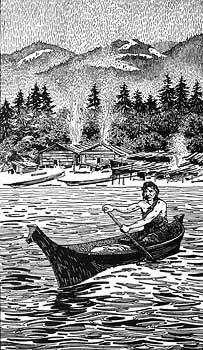
To the lone Indian, who slowly paddles his canoe upon the waters of
this western sound, each tree of different kind by shade of green and
shape of crown is known; the Toh-a-mupt or Sitca spruce with scaley
bark and prickly spine; the feathery foliage of the Quilth-kla-mupt,
the western hemlock, relieved in spring by the light green of tender
shoots. The frond-like branches and aromatic scent betray to him the
much-prized Hohm-ess, the giant cedar tree, from which he carves his
staunch canoe. These form the woods which sweep from rocky shore to
topmost hill.
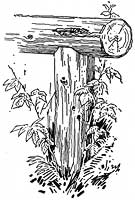 Small bays with sandy beaches white with broken clam shells mark the
shore, and if across the beach a stream of crystal water rippled
to the sea, one Indian lodge or more was sure to be erected on the
rising land behind; for Indians always choose to build their homes
on sheltered sandy bays where pure fresh water runs, and so in years
which are among those past and gone one could not fail to see the
blue wood smoke of Indian fires hanging like gauze above the little
bays; but most are now deserted and corner posts of old time houses
alone are seen, and beds of stinging nettle cover ancient kitchen
middens, and spirea and elderberry strive for space where once red
strips of salmon hung in the smoke of punk-wood fires, and stillness
reigns where once the Indians' mournful song was heard.
Small bays with sandy beaches white with broken clam shells mark the
shore, and if across the beach a stream of crystal water rippled
to the sea, one Indian lodge or more was sure to be erected on the
rising land behind; for Indians always choose to build their homes
on sheltered sandy bays where pure fresh water runs, and so in years
which are among those past and gone one could not fail to see the
blue wood smoke of Indian fires hanging like gauze above the little
bays; but most are now deserted and corner posts of old time houses
alone are seen, and beds of stinging nettle cover ancient kitchen
middens, and spirea and elderberry strive for space where once red
strips of salmon hung in the smoke of punk-wood fires, and stillness
reigns where once the Indians' mournful song was heard.
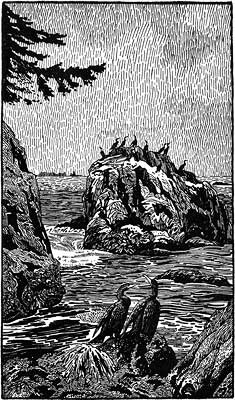 |
| On jutting rocks the black Klap-poose, the
shag, in silence sits. |
Between the bays are rugged rocky points, where, by the constant
wash of winter waves the rocks are carved in shapes uncouth and
weird--giants in stone, whose heads are crowned with scrubby
conifers, upon whose feet the wild seas break, or in the summer time
the gentle wavelets lap. On jutting rocks the black Klap-poose, the
shag, in silence sits, while circling overhead the keen eyed gulls
watch for the shoals of fry on which they feed.
Come now with me and I will guide you to some beauty spots, unknown,
unguessed except to those who have explored the sea creeks and
sheltered passage ways abounding on that western coast. Perhaps
between two rugged rocks we may find an opening where it cuts its way
deep into the land. In many parts, the lichen-covered canyon walls
approach so close together that our canoe can scarcely pass, and more
than likely we shall find the passage bridged by some old fallen
tree, its ancient trunk enveloped in soft moss and seedling forest
trees. Reflected in the water's surface are flowering berry shrubs,
which adorn the banks on either side. We see the glossy-leaved
shalal, the fruit of which the Indians gather to dry for winter use,
and clumps of maiden hair and other ferns rooted in old tree trunks
and rocky crevices. Such is the picture of many a salt sea creek
found in the regions round fair Barkley Sound.
Perhaps our fancy leads among the islands of the sound. It may be
that a storm has lately spent itself, and long deep swells are
rolling in from the wide ocean lying to the west. Our staunch canoe
is lost in the deep green waters of the heaving main. It climbs only
to descend and climb once more, and thus we slowly cross the Middle
Channel and reach calm water.
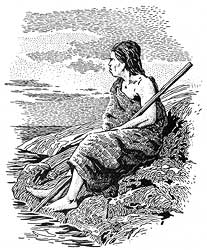 |
| A west coast Indian wearing the kut-sack. |
Soon what at first appeared to be unbroken shore breaks up into many
passage ways. By one of these we enter, to find ourselves among a
hundred isles. Each one is wooded to the water's edge, which often
the trees overspread with outstretched boughs. Entranced, we paddle
on until we leave behind all trace of ocean swell, and if the tide
be low so that old sea-soaked snags are seen upon the shore, and
boulders thick with barnacles and varied coloured sea-weeds in shades
of brown and red, and here and there great clusters of blue mussel
shells, these all, if the water be calm and undisturbed by wind, are
mirrored on the surface of the stream, forming pictures most rare
and beautiful. Thus for hours with ever fresh delight we thread the
calm passage-ways between those isles. Beachlets of white sand and
powdered shells are found where ocean swells at times may reach. On
these we stroll and gather abalone shells and empty sea eggs and
other relics up-thrown by winter storms. At evening we may reach
a sheltered nook where years ago Indians built a little shelter
in which to sit and watch the sun descend into the western sea.
Perhaps we may conjure up the Indian's thought, who built that
little shelter, and night on night in glorious summer time, squatted
and watched the sun go down.
Such is the setting for the following tales. Amid such scenes as
these, the Indians lived and died.
The Summer Home of the Seshahts
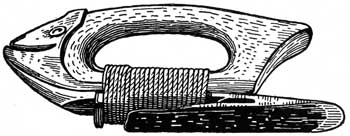 |
| Hand Adze made and used by Indians of Barkley Sound. |
There is an island larger than the rest, called Ho-moh-ah, where once
the tribe of Seshahts made their summer home. It lies well out to
sea, and on the sheltered side the Seshahts lived. The chief of the
tribe was Shewish. His house was large, so large that when he called
his people to a great potlatch, they all could find within its walls
an ample space to feast and dance. His house like all the old time
dwellings was built on simple lines, the three great roof-logs each
of single trees, upheld by posts of ample girth. The sides and roof
of wide-split cedar boards were adzed to lie close, and fastened
into place by twisted cedar rope. Within, on either side was raised
a wooden platform two feet high. This platform and a portion of
the floor adjoining it in sections was partitioned off by screens
of cedar mats. Each section was the home of such as claimed close
kinship with the chief. The centre of the lodge for its whole length
was common to all who lived therein. The people cooked their food
upon the common fire, the smoke of which curled up and found an exit
through the smoke hole in the roof. The section tenanted by the
family of Shewish lay furthest from the door. No feature except one
marked it as different from the homes of lesser men. A pictographic
painting--the Coat of Arms of the great family of Shewish hung upon
the wall. The picture told in graphic form how came the name of
Shewish to be famed among the hunters of the whale. It also told
the legend of the THUNDER BIRDS.
Next: The Legend of the Thunder Birds
Copyright © 2003-2006 Calvin & Rosanna Hamilton. All rights reserved.

 Small bays with sandy beaches white with broken clam shells mark the
shore, and if across the beach a stream of crystal water rippled
to the sea, one Indian lodge or more was sure to be erected on the
rising land behind; for Indians always choose to build their homes
on sheltered sandy bays where pure fresh water runs, and so in years
which are among those past and gone one could not fail to see the
blue wood smoke of Indian fires hanging like gauze above the little
bays; but most are now deserted and corner posts of old time houses
alone are seen, and beds of stinging nettle cover ancient kitchen
middens, and spirea and elderberry strive for space where once red
strips of salmon hung in the smoke of punk-wood fires, and stillness
reigns where once the Indians' mournful song was heard.
Small bays with sandy beaches white with broken clam shells mark the
shore, and if across the beach a stream of crystal water rippled
to the sea, one Indian lodge or more was sure to be erected on the
rising land behind; for Indians always choose to build their homes
on sheltered sandy bays where pure fresh water runs, and so in years
which are among those past and gone one could not fail to see the
blue wood smoke of Indian fires hanging like gauze above the little
bays; but most are now deserted and corner posts of old time houses
alone are seen, and beds of stinging nettle cover ancient kitchen
middens, and spirea and elderberry strive for space where once red
strips of salmon hung in the smoke of punk-wood fires, and stillness
reigns where once the Indians' mournful song was heard.


